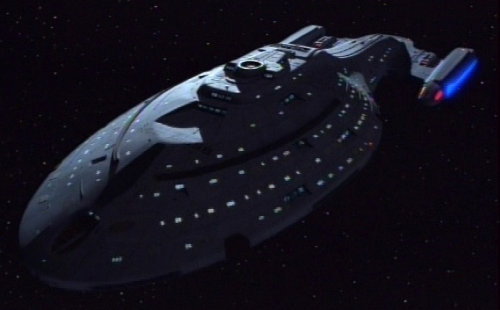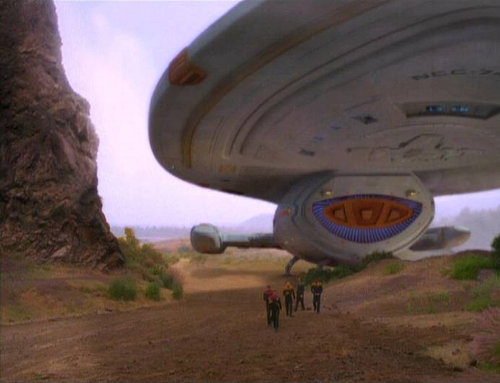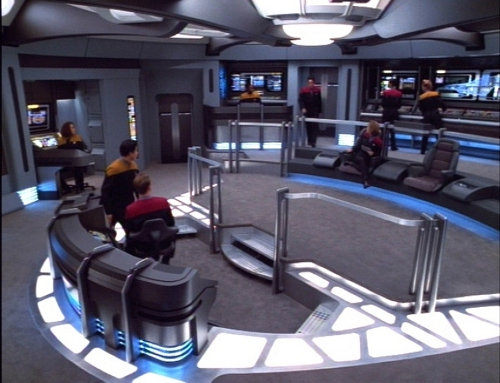Intrepid class
The Intrepid class represented a departure for Starfleet, away from large, complicated designs like the Nebula and Galaxy classes toward constructing smaller and more efficient vessels.[1] Developed in tandem with the Sovereign class heavy explorer, the Intrepid class shared many new technologies with its larger cousin,[2] including bio-neural computer systems[3] and multi-spectral shielding.[2]
The Intrepid class was designed to reach distant star systems and fulfill a variety of mission profiles, including exploration, survey, courier, and even interdiction.[1] Atmospheric landing capabilities allowed the class to make planetfall[4] to make repairs or conduct extended scientific missions. Foremost fast explorers, the Intrepid class was able to reach distant star systems in considerably less than time than older, and larger, starships. Once on station, the Intrepid class was well equipped to deal with a variety of situations, something that became a hallmark of the class early into its service life.[1] The Intrepid class was one of the fastest starship classes in the fleet,[2] boasting an impressive top speed of Warp 9.975 for an extended duration.[3]
| Date Entered Service | 2370[3] |
| Length | 344.5m[5] |
| Width | 132.1m[5] |
| Height | 64.4m[5] |
| Decks | 15[3] |
| Mass | 700,000mt[5] |
| Transporters | • Personnel: 6[2] • Emergency: 6[2] |
| Crew | 150[3] |
| Shuttlecraft | 6[2] |
| Velocity | • Cruising Speed: Warp 6[2] • Maximum Safe Speed: Warp 9.6[2] • Emergency Speed: Warp 9.975[3] |
| Armaments | • 11[5] Type X Phaser arrays[3] • 4[3] Mark 95 direct-fire torpedo tubes;[1] 40[1] Type VI[2] Photon torpedoes[3] |
Loss of the U.S.S. Voyager NCC-74656 shortly after launch put some doubt into the abilities of the class, but these concerns were dismissed as Intrepids began to prove themselves in a number of different arenas.[1] Several years later, Starfleet learned that Voyager was not only still operational, trapped in the Delta Quadrant and making its way back to Federation space.[6] Along the way, Voyager made contact with numerous new species, overcame seemingly insurmountable odds, and even did encountered the Borg on several occasions.[1] Voyager's return in 2377, via a Borg Transwarp corridor,[7] provided immeasurable data on the performance of the class. Meanwhile, during the Dominion War, Intrepid class vessels fought with some success, but were never called upon for any extended assignments. Their speed and sensor capabilities made them formidable scouts, providing important data and making them more valuable as fast-attack craft and special mission starships.[1]
Several design innovations made their first appearance on the Intrepid class, among them one of the fastest warp engine designs to that point. The LF-45 linear warp drive,[1] streamlined hull design, and variable-geometry warp nacelles—which the crew could subtly move to maximize warp field performance—coupled with the auxiliary deflector dish,[2] allowed the Intrepid class to reach speeds of up to Warp 9.975.[3] This new engine and nacelle design enabled the class to make do with a much smaller propulsion system than those found on other vessels of comparable size; in fact, the small size of the core allowed the class to carry components to construct a spare warp core, if necessary.[1]
Employing a new kind of circuitry in the form of bio-neural gelpacks,[3] which incorporated synthetic neuron analogs in a nutrient gel medium,[8] the optical data network aboard the ships mimicked the way a humanoid brain functioned.[1] This sped data functions across the network, improving overall performance and providing a substantial increase in computing power.[3]
Given its primary mission profile of exploration and surveying, the Intrepid class also possessed impressive scientific and medical systems. Engineers could swap out or upgrade its multifunction laboratory compartments for specific missions.[2] Its Mark I Emergency Medical Hologram provided medical care in the absence of living doctors.[3]
The class' armaments were equally impressive for a vessel of its size; it mounted the same Type X Phaser arrays found on larger starships, such as the Galaxy class, enabling it to produce the same phaser output as larger vessels, allowing them to conduct close-quarters defense and offer superb threat deterrence and accurate targeting. Mark 95 direct-fire multi-function torpedo launchers allowed for the use of either photon or quantum torpedoes, as well as probe deployments. Due to its smaller size, however, the Intrepid class did not boast the extensive torpedo loadouts often found on larger vessels; the class typically carried fewer than 40 projectiles.[1]
Intrepid class vessels
U.S.S. Bellerophon NCC-74705 • U.S.S. Intrepid NCC-74600 • U.S.S. Voyager NCC-74656
LUG Timeline
U.S.S. Blackthorne NCC-76719 • U.S.S. Gallant NCC-74882 • U.S.S. Intrepid NCC-74620 • U.S.S. Nelson NCC-74718 • U.S.S. Vanguard • U.S.S. Voyager NCC-74656 • U.S.S. Zealous NCC-74732
First Splinter Timeline
U.S.S. Pathfinder NCC-74562 • U.S.S. Sagan NCC-75055 • U.S.S. Stargazer NCC-2893-A • U.S.S. Voyager NCC-74656
STO Timeline
U.S.S. Bellerophon NCC-74705 • U.S.S. Intrepid NCC-74600 • U.S.S. Voyager NCC-74656
V201 Timeline
Notes and References
- ↑ Jump up to: 1.00 1.01 1.02 1.03 1.04 1.05 1.06 1.07 1.08 1.09 1.10 1.11 "Starships." Star Trek Roleplaying Game, Book 4. Game. 2003. Decipher, Inc.
- ↑ Jump up to: 2.00 2.01 2.02 2.03 2.04 2.05 2.06 2.07 2.08 2.09 2.10 "Starfleet Operations Manual." Star Trek Roleplaying Game, Book 3. Game. 2003. Decipher, Inc.
- ↑ Jump up to: 3.00 3.01 3.02 3.03 3.04 3.05 3.06 3.07 3.08 3.09 3.10 3.11 3.12 "Caretaker." Star Trek: Voyager, Episodes 101-102. Television. 16 January 1995.
- ↑ "The 37s." Star Trek: Voyager, Episode 120. Television. 22 May 1995.
- ↑ Jump up to: 5.0 5.1 5.2 5.3 5.4 "Player's Guide." Star Trek Roleplaying Game, Book 1. Game. 2002. Decipher, Inc.
- ↑ "Pathfinder." Star Trek: Voyager, Episode 230. Television. 1 December 1999.
- ↑ "Endgame." Star Trek: Voyager, Episode 271. Television. 23 May 2001.
- ↑ "The Cloud." Star Trek: Voyager, Episode 106. Television. 13 February 1995.



